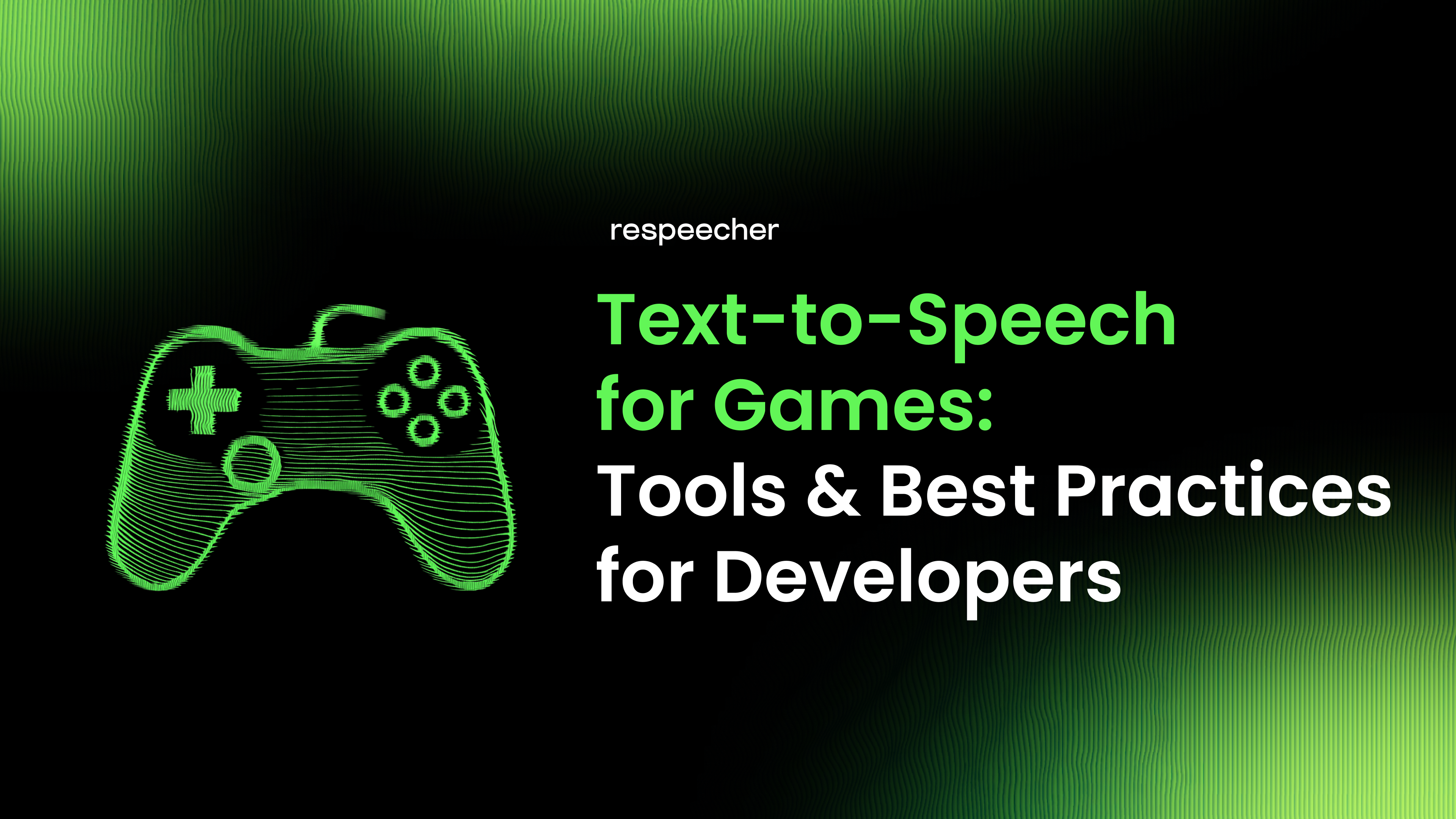Text-to-Speech for Game Developers: What to Use and How to Use It

When game developers look for new ways to add depth, responsiveness, and accessibility to their worlds, text-to-speech (TTS) is quickly becoming—quite literally—a practical game-changer.
Bring lifeless NPC dialogues to life, amp up immersion, and open up storytelling options that used to be reserved for big-budget AAA titles — we’ll cover the essentials and share some handy TTS best practices for game developers. All that while keeping your workflow smooth and your audio legally sound.
Key Takeaways
- Text-to-speech (TTS) in gaming gets your NPCs off mute, brings real interaction to the table and unlocks features that once only big-budget AAA games could afford.
- Real-time dialogue will only work if it happens in a snap. Choose a TTS tool that’s quick on the draw (200ms) or risk your players waiting in awkward silence.
- The biggest risk in video game text-to-speech—worse than bad audio—is bad ethics. Partner with a provider that is 100% transparent about their voice data.
Why Game Developers Are Turning to Text-to-Speech
The real reason text-to-speech for gaming is being adopted is not for the 'wow' factor, though it has profoundly improved. This practical tool solves some of the most persistent problems for dev teams:
Giving NPCs More Than One Line to Say
You've spent years building a massive, detailed city, only for every player to notice that all 50 guards say the same thing. Recording unique lines for every background character is almost unrealistic—or, if it is realistic, it’ll be way too costly.
Gaming text-to-speech lets you generate thousands of dialogue variations, making your world feel populated and alive instead of like a collection of audio-file-repeating robots.
Getting Faster Placeholder Audio
You need to know if a cutscene's timing works—probably, right now—but you don't have the final voice-over. The usual solution is to have a producer record a "scratch" track, which often sounds flat and not really helpful.
High-fidelity TTS in gaming lets you generate a genuinely good-sounding placeholder in seconds. You can drop it in the build, see if the joke lands, and iterate on the script — all before the final voice actors are recorded.
Creating Dialogue With the Player
Text-to-speech, particularly real-time systems, can create a dialogue that responds to the player, which makes a more personal game world.
This could be an in-game sports announcer who says the player's custom name or a companion who makes a specific comment on the unique (and weird) set of armor the player just equipped — some kind of personal commentary that makes the world feel like it's actually paying attention.
Integrating TTS Into Your Games: How It Works
If you want to use video game text-to-speech with a strong guarantee it won’t sound like an old GPS, you first should understand what you're working with.
Text-to-speech API is a service that lets your game engine send text to a voice system and get back a high-quality audio file. Your choice of TTS in games, however, depends entirely on what you need the audio to do:
- Standard TTS: You generate all your audio files during development, then add them to the game build. This approach is ideal for prototyping, localization, or generating thousands of lines for NPCs with known, static dialogue.
- Real-Time TTS: The audio is generated live while the game is being played. This is what you need for any dynamic dialogue, like an NPC reacting to a player's specific action. The audio must have low latency; it has to be created and played in milliseconds, otherwise, the player is just left staring at a silent character.
How to Integrate TTS in Your Game Engine
Integrating TTS technology in gaming is usually the same three steps:
- Your engine sends the dialogue line to the TTS API.
- The API’s voice model generates the audio and returns the data.
- Your engine catches the audio and plays it at the right moment.
To make this even easier, most providers offer an SDK (Software Development Kit) – the tool that plugs into Unity or Unreal and manages the technical details of the connection, audio streaming, and playback for you.
Examples of Text-to-Speech Voices for Game Characters
TTS technology has finally caught up with our imaginations and made it possible to create just about any voice we can dream up. Let’s have a look at a few common examples of text-to-speech for video game characters:
- The energetic hero voice. Your go-to voice for protagonists and key companions — it has a clear tone and confident energy, which means the lines are delivered with purpose.
- The gruff villain / tough NPC. This voice is for your antagonists or the tough guards blocking the path — deep, raspy, or a bit menacing. It sounds like it’s been through a few brawls and surely isn't afraid to growl when needed.
- The wise mentor / narrator. A voice that commands respect without shouting. Calm, warm, and measured, this style fits mentors, quest givers, or narration perfectly — someone who guides players with patience and a touch of gravitas.
- Sci-Fi & fantasy voices. The voices of things that go beep in the night, or sputter in the spaceship. Robots, aliens, ethereal beings also get their own buzz, eerie echo, or timbre thanks to professional video game text-to-speech tech.
- Functional & accessibility voices. For the unsung hero of your game’s interface: clear, no-nonsense, and easy on the ears. It’s the one calling out menu options and tutorial tips so every player can figure out how to roll that epic dice.
- Specific regional accents. Nothing makes a character sound like a local like an actual local accent. Integrating TTS into games with specific characters’ backstory pays its huge share to make your world feel more real.
Best Practices for Using TTS in Games
TTS lets your game speak, but does it sound good, legal, and respectful? To keep your players hooked (and off the mute button), here’s the no-nonsense guide to picking voices:
Prioritize High-Quality Voices
The monotone voice on a basic model is what everyone is afraid of. Don't use it. The only text-to-speech for gaming worth using is from models built for performance.
The best tools let you direct the style, the emotion, or the specific tone. You're trying to get a character that sounds like they're in the game, not like they're bored reading a script.
Ensure Ethical Sourcing and Voice Rights
Know exactly where your voices are coming from: TTS providers must guarantee their models are built on ethically sourced data.
If a provider isn’t clear about this, consider it a big warning sign. Using voices scraped or taken without permission is unethical and a major legal risk no developer should take.
Blend AI Voices with Human-Recorded Audio
The smartest TTS integration is a hybrid one. Let your human actors handle the big emotional moments and hero lines — they bring the heart and soul.
Meanwhile, offload those endless NPC lines, UI narration, and dynamic responses to TTS. You get the top-quality sound where it counts and efficient coverage everywhere else.
Troubleshooting TTS in Gaming: Common Challenges and Fixes
Getting text-to-speech for games to work well means understanding what can go wrong. Most common challenges are fixable — you just have to face them head-on.
Voices Sound Robotic
The voice you get from free TTS models has zero emotion, zero charm, and sounds about as lively as a dial-up modem. Perfect if you want your intense boss fight to feel unintentionally hilarious, or if you’re looking to suddenly acquire a lawsuit.
Solution: High-fidelity models with performance controls
Modern TTS engines are using advanced models designed to mimic human speech nuances. These come with performance controls that allow you to turn generic text reading into an engaging character.
High Latency for Real-Time Dialogue
Waiting a few seconds for your NPC to respond during a heated game moment can get pretty annoying. Too many laggy dialogues break the flow and pull players right out of the game experience.
Solution: A low-latency (real-time) TTS API
You need an API ready for milliseconds-level response times. Real-time APIs built for gaming deliver speech fast enough to keep conversations flowing naturally, even when they are generated dynamically during gameplay.
Difficult Technical Integration
Your dev team gets excited until they open the documentation and find a maze of unclear instructions.
Solution: Clear documentation and engine support
That’s how you’ll save your team the headache. A professional provider will have an easy-to-use SDK built for your engine—Unity or Unreal—and documentation that’s actually helpful.
Best Text-to-Speech Providers for Video Game Audio
One single 'best' text-to-speech for games doesn't exist, but the 'right' one does, and it depends on your project.
#1. Respeecher
We focus on giving high-quality, professional and ethical voice solutions built on a non-negotiable foundation. Our team offers two distinct technologies for game developers:
- For in-game dynamic dialogue, meet our brand-new Real-Time TTS API. It delivers audio in 200ms, which is essential for responsive character lines that won't feel delayed. We also provide SDKs for both Unity and Unreal to simplify your technical integration.
- Our separate Speech-to-Speech (STS) technology is a high-fidelity solution for any voice transformation. This is the tech that—with full family consent—was used to preserve Miłogost Reczek’s performance as Viktor Vektor in Cyberpunk 2077: Phantom Liberty.
That project is our core philosophy in action: we are built on transparent licensing, fair compensation for actors, and the strict use of 100% consented voice data.
#2. TypeCast
TypeCast is a web-based platform built around a large library of over 600 preset "AI voice actors." You can "cast" different voices for different roles and then adjust the performance with specific emotions ("engaging" or "suspicious"), tone, and style for each line.
The process is built around generating and downloading audio files (MP3 or WAV) to be imported manually into an engine. While it does offer a REST API, it's primarily known for this direct-download method.
#3. Murf AI
Murf.ai is the reliable straight-shooter: huge voice library, solid languages, zero fuss. It packs over 200 professional voices in 33 languages and accents — important for localization tests or generating decent-sounding placeholder dialogue.
Its editor’s a simple timeline, perfect for syncing voiceovers to visual content without needing video-editing Jedi skills. Their voice cloning tool lets you create custom AI versions of your own or other voices — a neat bonus for character-driven games.
Final Thoughts
Real-time, low-latency dialogue is exciting tech, but a much bigger story is told by ethics. The next chapter in game audio will reward platforms that promise 100% consented, high-fidelity and quality voices.
Your studio’s pick for an audio partner says a lot about how you do things. That’s why our Real-Time TTS is built for devs who want swift response times without cutting corners on voice quality or fairness.

FAQ
Yes, you can and you should. Real-time tools like Respeecher’s TTS API create voice lines in 200 milliseconds, which results in:
- NPCs’ dynamic reaction to player actions
- No awkward delays
- Personalized experiences
Absolutely. Text-to-speech for games gives indie studios a handy shortcut to lots of different character voices without blowing their budget.
Good TTS technology in gaming notices feelings, tone, and flow to sound more real. Still, for the big story scenes, it’s best to mix TTS with real voice actors so it feels genuine.
When using AI Text-to-speech for video game characters’ localization, it’s important to keep their voice consistent and believable no matter the language.
- Use TTS tech to adjust regional accents and emotions — a much faster, cheaper way than hiring new voice actors for every language, and it keeps your character recognizable.
- Translations change dialogue length, which can also mess with timing. Have a plan to edit and sync audio so your cinematic cutscenes and gameplay flow don’t turn into a hot mess of mismatched lip-sync.





